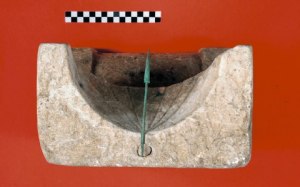
It is noteworthy that in the Ancient Greek world, sundials consisted of a gnomon (indicator in Ancient Greek) in the form of a vertical post or peg set in a flat surface, upon which the shadow of the gnomon served to indicate the time.
This sundial has a surface which is separated in 12 parts representing 12 hours of the day. More particularly, the sundial consists of a hyperbola tracing the shadow’s path at the winter solstice, a second one for the summer solstice, and a straight east-west line in between marking the equinoctial shadows.
A line from the base of the gnomon to the south of the dial running due north denotes noontime. The hyperbola is centered on this noon line. The winter hyperbola opens to the north, the summer hyperbola to the south. In addition to the center noon line, additional oblique lines are added on either side to denote the hours of daylight before and after noon.
Archaeologist of the 16th Ephorate of Prehistoric and Classical Antiquities, Betina Tsigarida, specialist in the area of Chalkidiki, was the one to find the sundial and was given it as a reward for her work.
See all the latest news from Greece and the world at Greekreporter.com. Contact our newsroom to report an update or send your story, photos and videos. Follow GR on Google News and subscribe here to our daily email!



